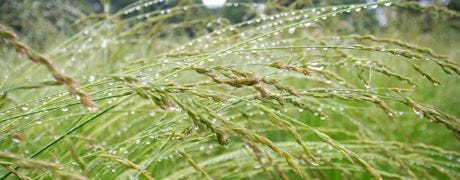May 10, 2014

Livestock producers may see more stems on hay this year as cool weather slowed growth of some grasses.
Lack of sunshine and warmth delayed grass leaves growth in many pastures across the state. By mid-May, the shortened grass begins to set seed heads.
That indicates the end of rapid grass growth for cool-season species.
"Once seeds set, the vegetative growth slows," says Rob Kallenbach, University of Missouri Extension forage specialist.
"Quality grazing and hay growth comes with elongation of grass leaves," Kallenbach says.

Fescue seed heads contain a higher content of a fungal poison called ergovaline, which causes health problems for cattle eating fescue grass or hay with seed heads.
When seed heads reach boot stage, when still encased within the leaves, stem elongation starts, he says. Unlike leaves, stems contain few nutrients. They are built for strength. They don't make edible forage.
Stemmy hay
"I expect to see a lot of stemmy hay this year," Kallenbach told MU regional agronomist by teleconference last week.
Every year, Kallenbach urges Missourians to start making hay the first week of May. That's when most growth produces leaves, not stems. After that, delayed harvest lowers feed quality as stems increase.
Early cutting of grass for hay becomes more important this year, he says. There's not as much leaf, but there will be more stems in the hay.
Farmers are seeing seed heads even before they see strong stands of grass.
Seed head emergence brings more problems on fescue pastures. The seeds contain higher content of a fungal poison found in most tall fescue in the state. That poison, ergovaline, causes health problems for cattle eating fescue grass or hay with seed heads.
Day length triggers seed heads, not how tall grass has grown, Kallenbach says. With or without leaf growth, seeds start the reproduction cycle at a set time in the season.
Kallenbach measures grass growth weekly in his studies at the MU research centers. Those are part of the MU College of Agriculture, Food and Natural Resources.
~~~PAGE_BREAK_HERE~~~
"Last week, we grew only 40 pounds of dry matter per acre per day," he says. "I was expecting 80 pounds, as we did have some warm days."
With a shortage of cool-season grass, farmers attempt to plant warm-season grass early for summer grazing.
"I've seen some Sudan grass being planted already," Kallenbach says. "That's asking for trouble. Warm-season annuals starting slow in cold soil never catch up."
Kallenbach advises waiting to plant summer forages such as crab grass or pearl millet until soil temperatures rise above 60 degrees. That's above soil temperatures for planting corn.
Earlier in the teleconference, Pat Guinan, MU Extension climatologist, said soil temperatures remain too low across much of northern Missouri for crop planting. With cool nights, soil temperatures stay in the 40s, even dropping into the 30s.
Major pest
Wayne Bailey, MU Extension entomologist, says alfalfa weevils remain a major forage pest. Both leaf-eating larvae and adult weevils laying eggs are abundant. They pose a threat to the first cutting and the second cutting of alfalfa hay.
However, if temperatures reach 90 degrees with rain, as forecast, alfalfa weevils face death. Heat and humidity favor a fungal disease that infects the larvae.
"The infected weevils stop eating, even if they don't die," Bailey says. "If the fungus fails, we will be in trouble. Spraying insecticide becomes more effective as weather warms."
Alfalfa hay can be cut up to 10 days early to slow weevil damage. However, stubble fields must be scouted often after haying. "It takes only a small residual population to damage a stand of alfalfa," Bailey says.
Whether the field was sprayed or not, the stubble must be watched. Both larvae and adults damage new growth.
As the alfalfa stand thins, weeds emerge to further crowd out the forage crop.
Source: University of Missouri Extension
You May Also Like




